© Copyright 2010 • American Immigration Council • All Rights Reserved | Contact Us
The Growing Political Power of Immigrants and their Children
At a time when federal, state, and local elections are often decided by small voting margins—with candidates frequently locked in ferocious competition for the ballots of those “voting blocs” that might turn the electoral tide in their favor—one large and growing bloc of voters has been consistently overlooked and politically underestimated: New Americans. This group of voters and potential voters includes not only immigrants who have become U.S. citizens (Naturalized Americans), but also the U.S.-born children of immigrants who were raised during the current era of large-scale immigration from Latin America and Asia which began in 1965 (the Post-1965 Children of Immigrants). These immigrants and their children have a powerful and highly personal connection to the modern immigrant experience that most other Americans do not. It’s one thing to hear family stories about a grandfather or great-grandfather coming to the United States during the much-romanticized “Ellis Island” era of immigration from Europe that ended decades ago. It’s quite another to belong to a family that is experiencing first-hand the political and economic realities of immigration today. The ranks of registered voters who are New Americans, or Latino or Asian, have been growing rapidly this decade and are likely to play an increasingly pivotal role in elections at all levels in the years to come, particularly in battleground states like Florida, Colorado, Nevada, and New Mexico. As public opinion polls reveal, anti-immigrant political rhetoric is likely to motivate many New Americans to cast ballots, but is unlikely to win many votes for candidates perceived as anti-immigrant.
Download the Executive Summary [1]
Download the Special Report [2] (below)
_________________________________________________________________________________________
New American, Latino, and Asian Voters at the National Level
The electoral power of New American voters is significant
- There were 15 million New American registered voters in 2008
New Americans were 10.2 percent of all registered voters
There were 15.0 million New Americans registered to vote in 2008, totaling 10.2 percent of all registered voters (see Table 1 and Figure 1).
- 9.3 million were Naturalized Americans.
- 5.7 million were Post-1965 Children of Immigrants.

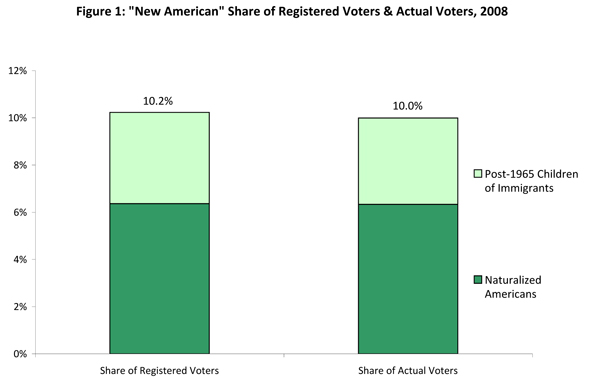
New Americans were 10.0 percent of actual voters
13.1 million New Americans voted in 2008, representing 10.0 percent of all those who voted (see Table 1 and Figure 1).
- 8.3 million were Naturalized Americans.
- 4.8 million were Post-1965 Children of Immigrants.
The electoral power of Latino and Asian voters is significant
- There were 15.6 million Latino and Asian registered voters in 2008
Latinos and Asians were 10.7 percent of all registered voters
Together, Latinos and Asians constituted 15.6 million, or 10.7 percent, of all registered voters in 2008 (see Table 2 and Figure 2).
- 11.6 million Latinos accounted for 7.9 percent of all registered voters.
- 4.0 million Asians accounted for 2.8 percent of all registered voters.

Latinos and Asians were 10.1 percent of actual voters
Together, Latinos and Asians accounted for 13.2 million, or 10.1 percent, of all persons who cast a ballot in 2008 (see Table 2 and Figure 2).
- 9.7 million Latinos comprised 7.4 percent of all voters.
- 3.5 million Asians comprised 2.6 percent of all voters.
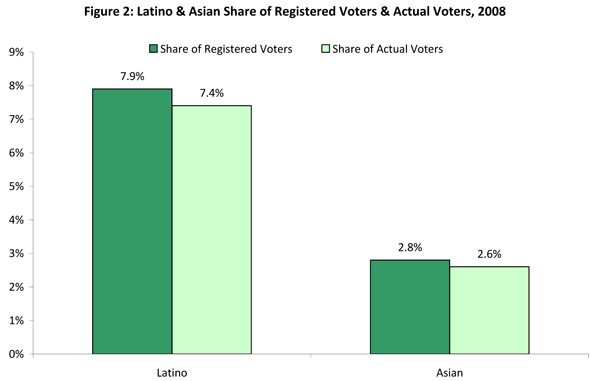
The electoral power of New Americans, Latinos, and Asians is growing fast
The number of New American registered voters increased by 7.5 million between 1996 and 2008
The number of New American registered voters rose by 7.5 million between 1996 and 2008—an increase of 101.5 percent (see Table 3 and Figure 3).
- Registered voters who were Naturalized Americans increased by 4.1 million—an increase of 79.9 percent.
- Registered voters who were Post-1965 Children of Immigrants increased by 3.4 million—an increase of 151.1 percent.

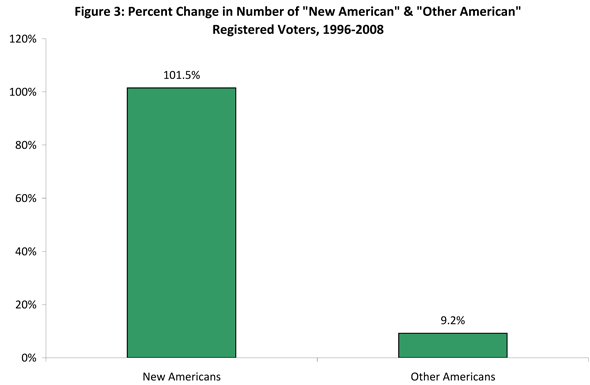
During the twelve years between the Presidential elections of 1996 and 2008, the New American share of registered voters increased by 4.4 percentage points. Conversely, the share of registered voters comprised of the rest of the population declined by 4.4 percentage points (see Figure 4).
- In 1996, New Americans were 5.8 percent of those registered to vote.
- By 2008, New Americans were 10.2 percent of registered voters (see Figure 5).
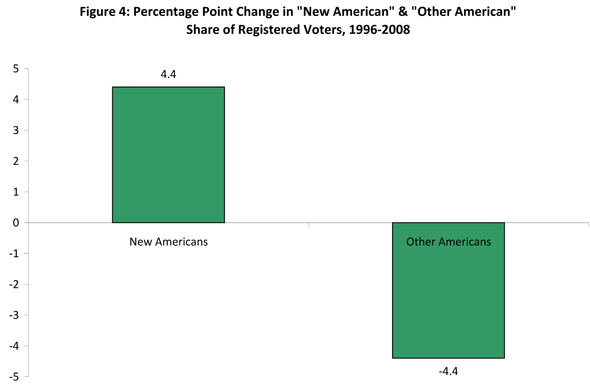
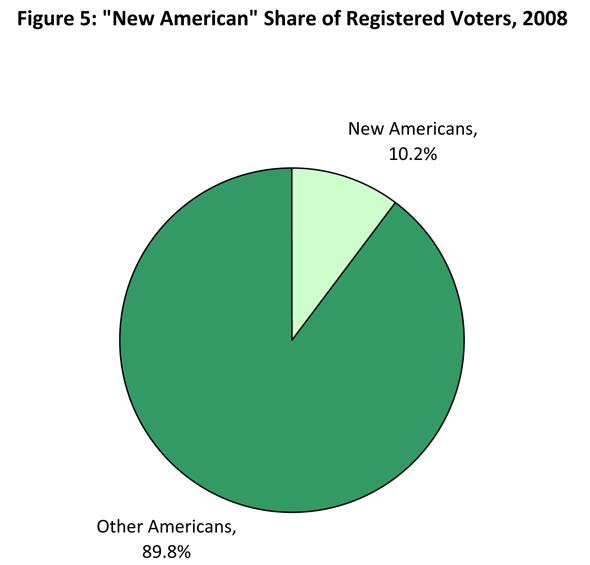
The number of Latino and Asian registered voters grew by 6.9 million between 1996 and 2008
The number of Latino and Asian registered voters increased by 6.9 million between 1996 and 2008 (see Table 4 and Figure 6).
- Latino registered voters increased by 5.0 million (an increase of 76.6 percent).
- Asian registered voters increased by 1.9 million (an increase of 87.9 percent).

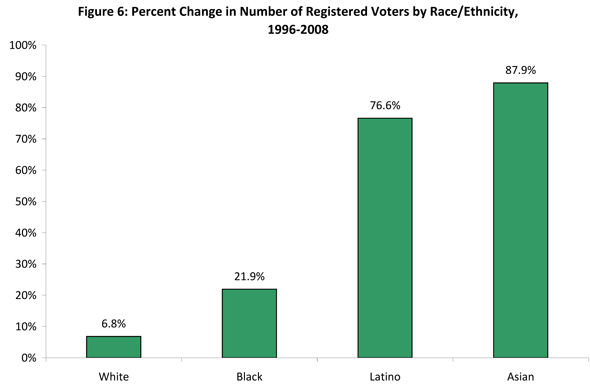
Latinos and Asians combined accounted for 10.7 percent of all registered voters in 2008 (see Figure 7).
- Latinos were 7.9 percent of registered voters.
- Asians were 2.8 percent of registered voters.
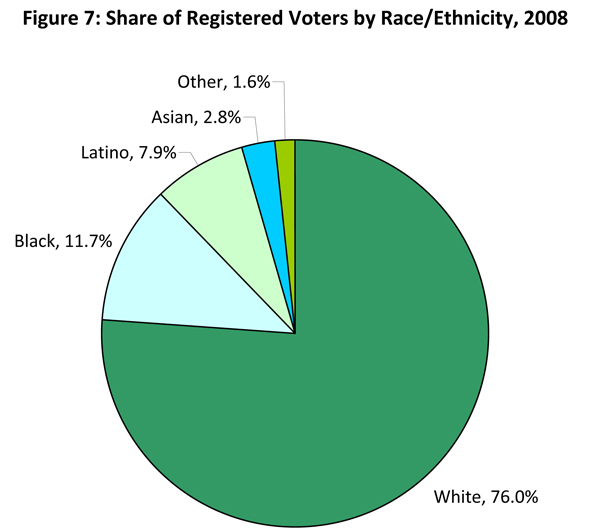
Between 1996 and 2008, the Latino share of registered voters increased by 2.8 percentage points and the Asian share by 1.1 percentage points. In contrast, the non-Latino white share declined by 5.5 percentage points (see Figure 8).
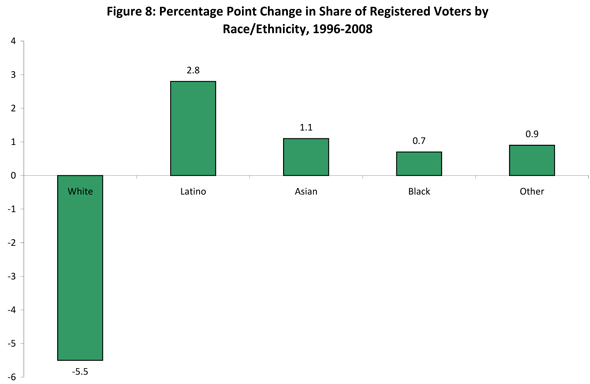
New American, Latino, and Asian Voters in Battleground States
New Americans, Latinos, and Asians are pivotal voting blocs in some battleground states
The New American share of registered voters is well above the national average in some battleground states
In certain states—including battlegrounds of the 2008 election—the New American share of registered voters is well above the 2008 national average of 10.2 percent. In these states, New Americans exercise critical electoral power as a mainstream voting group and not as marginal players whose votes are crucial only in close elections. In order to get elected in these states, a candidate must obtain significant support from New Americans.
New American voters have the greatest electoral power in California, where they accounted for 28.9 percent of all registered voters in 2008. However, New Americans comprise a significant share of registered voters in other electorally important states as well: Arizona (9.7 percent of registered voters in 2008), Florida (18.8 percent), Illinois (10.0 percent), Nevada (15.1 percent), New Jersey (18.8 percent), New York (17.5 percent), and Texas (11.8 percent) (see Figure 9 and Appendix 1).
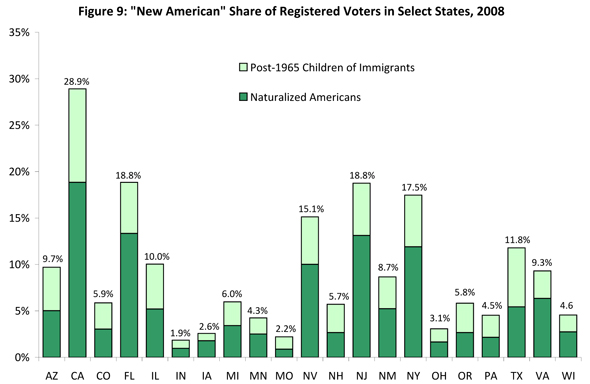
The New American share of registered voters was lower than the national average in battleground states such as Colorado, Michigan, New Hampshire, Pennsylvania, Oregon, and Virginia. But, in a close election, New American voters can be pivotal even in these states.
The Latino and Asian share of registered voters is well above the national average in some battleground states
States with relatively high shares of New American registered voters often have Latino and Asian shares of registered voters that are significantly above the 2008 national average of 10.7 percent: Florida (16.8 percent of registered voters in 2008), New Jersey (15.4 percent), New York (13.3 percent), Arizona (15.7 percent), Nevada (15.9 percent), and California (32.2 percent) (see Figure 10, Figure 11, and Appendix 2).
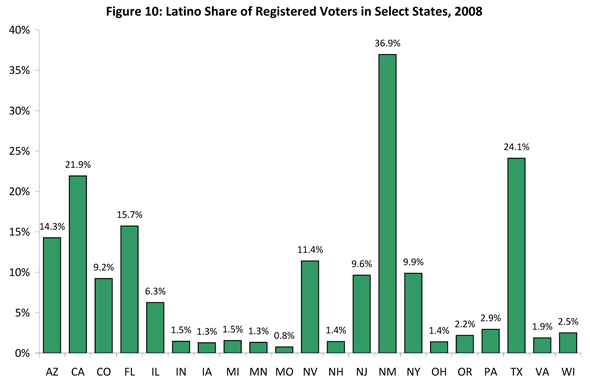
However, there are other states where, despite a comparatively low New American share of registered voters, the Latino and Asian share is relatively high: Colorado (11.4 percent of registered voters in 2008), New Mexico (38.7 percent), and Texas (25.8 percent) (see Figure 10, Figure 11, and Appendix 2).
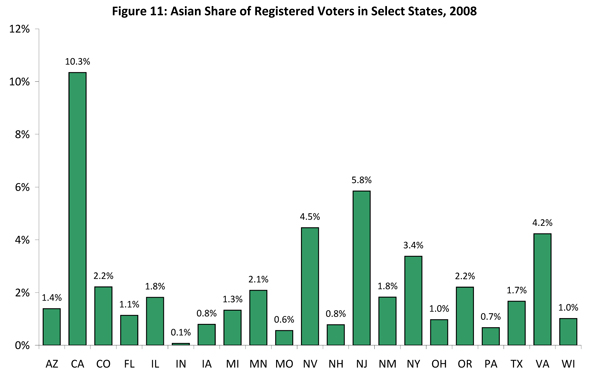
The Latino and Asian share of registered voters is lower than the national average in other battleground states such as Michigan, Pennsylvania, Oregon, and Virginia. But their numbers are sufficient to swing a close election in these states.
The electoral power of New Americans, Latinos, and Asians is growing fast in battleground states
The share of New American registered voters is increasing in nearly every battleground state
The New American share of registered voters increased in nearly every battleground and other key state during the twelve years between the Presidential elections of 1996 and 2008 (see Figures 12 and 13).
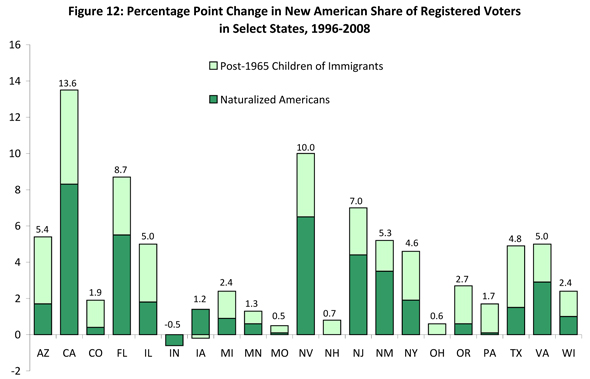
- In some states, the New American share of registered voters grew at rates well above the national average of 4.4 percentage points: California (13.6 percentage points), Florida (8.7 percentage points), Nevada (10.0 percentage points), and New Jersey (7.0 percentage points).
- In other states, the increase was not as great, but was still above the national average: Illinois (5.0 percentage points), New Mexico (5.3 percentage points), Texas (4.8 percentage points), and Virginia (5.0 percentage points).
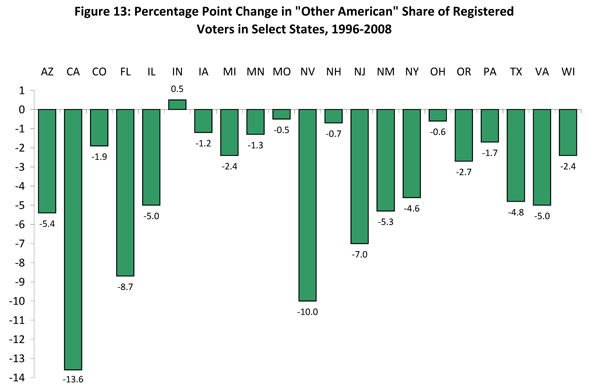
The share of Latino and Asian registered voters is increasing in nearly every battleground state
The Latino and Asian share of registered voters also increased in nearly every battleground state between 1996 and 2008 (see Figure 14 and Figure 15):
- Some states experienced increases in the Latino and Asian share of registered voters well above the national average of 3.9 percentage points: California (12.8 percentage points), Florida (7.0 percentage points), Nevada (9.0 percentage points), and New Jersey (6.4 percentage points).
- In other states, the increase was not as great, but was still above the national average: Illinois (4.5 percentage points), New Mexico (5.0 percentage points), and Texas (4.8 percentage points).
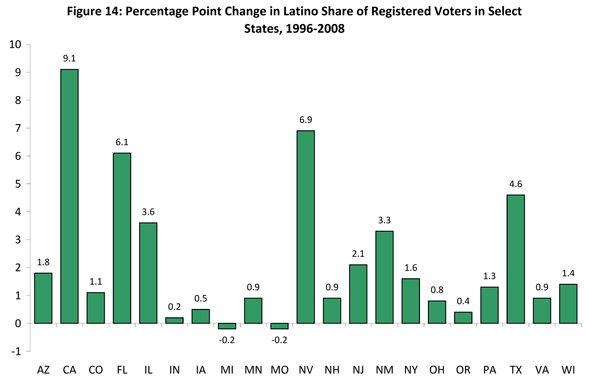
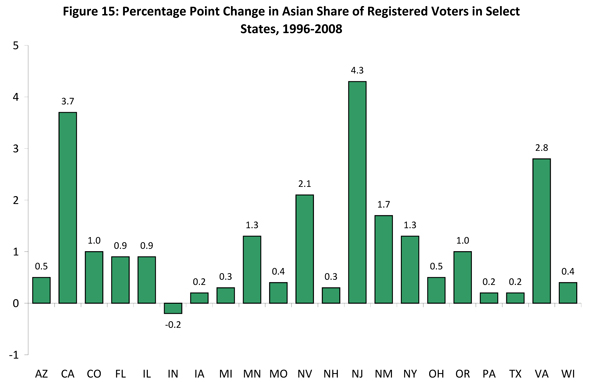
New Americans, Latinos, and Asians are pivotal voting blocs in battleground states even where their numbers are small
The electoral power of New American voters is greater than their numbers suggest
The electoral power of New Americans is not limited to those states where they are the most numerous. In an era when Presidential, Congressional, and state elections are often decided by thin voting margins, even a relatively small number of New Americans can have enormous electoral influence.
In Missouri, for example, there were only 71,174 New American registered voters in 2008, but that number was significantly larger than the 3,903 votes by which John McCain won the state. In Missouri and other states where the number of New American registered voters was greater than the margin of victory in 2008, the votes of New Americans could conceivably be decisive in similarly close elections today (see Table 5).
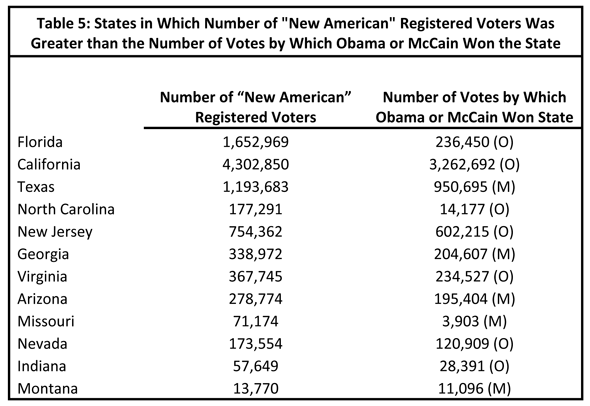
The electoral power of Latino and Asians is greater than their numbers suggest
As with New Americans, the electoral power of Latino and Asian voters is not limited to those states where they exercise critical electoral strength by sheer force of numbers. In battleground states in particular, the votes of Latinos and Asians can be pivotal in close elections. In Indiana, for instance, there were only 47,348 Latino and Asian registered voters in 2008, but that was significantly greater than the 28,391 votes by which Barack Obama won the state (see Table 6).
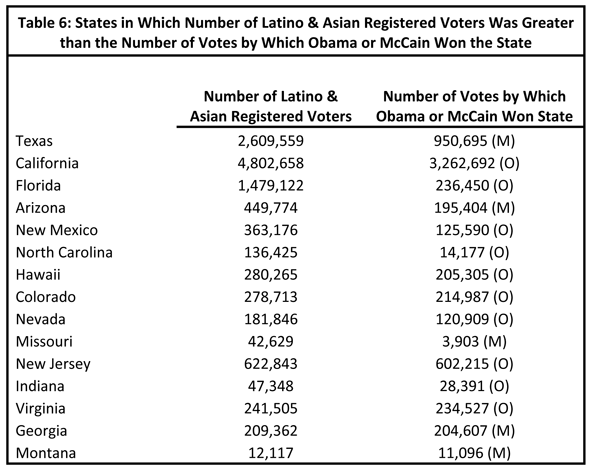
The Importance of Immigration as an Election Issue
Immigration appears to be a key issue driving the rise in naturalization rates and voter registration among New Americans, Latinos, and Asians. Following the passage of a harsh immigration-enforcement bill by the House of Representatives in 2006, millions of immigrants and their supporters engaged in unprecedented mobilizations around the country. Many demonstrators held signs reading “Today We March, Tomorrow We Vote.” Since then, the government has stepped up its immigration-enforcement activities. This has been met by an upsurge in civic-participation activity, including large increases in naturalization and voter mobilization.
New Americans, Latinos, and Asians, regardless of their immigration status, all feel the impact of the current environment—some because they or close family members are immigrants, others because they may “look like” immigrants in the eyes of government authorities and the broader public. Anti-immigrant policies affect not just immigrants, but the Latino and Asian communities in general.
All evidence points to the fact that New Americans, Latinos, and Asians have taken the “Tomorrow We Vote” mandate seriously. The 2008 elections were marked by a significant increase in new voter registrations and high levels of voter turnout by these voting blocs, driven in part by the stances that candidates took on immigration. Moreover, a poll conducted by LatinoMetrics in May and June of 2010 found that “since the end of 2009, immigration has catapulted to the top issue of personal concern among 1 in 4 Latinos—tied with jobs & the economy.” The poll also found that 8 in 10 Latinos regard immigration reform as being “of extreme importance.” Similarly, a poll conducted in June 2010 by Dr. Ricardo Ramirez for the NALEO Educational Fund found that 27 percent of Latino voters cited “immigration” when asked “what general issues would be most important to you in deciding whom to vote for?” Immigration ranked as one of the top three issues for one-third of Latino voters.
The political power of New Americans, Latinos, and Asians will continue to grow
The political power of New American voters will continue to increase in coming years as more and more children of immigrants come of voting age, more long-term legal immigrants become naturalized citizens, and increasing numbers of New Americans register to vote.
The key to the electoral power of New Americans is voter registration. In past elections, New Americans have had slightly lower registration rates than the rest of the U.S. population. However, once New Americans register to vote, they turn out to cast ballots at approximately the same rate as everyone else (see Figure 16). If more New Americans register to vote, it is likely that they will turn out in high numbers, thereby increasing their share of the electorate.
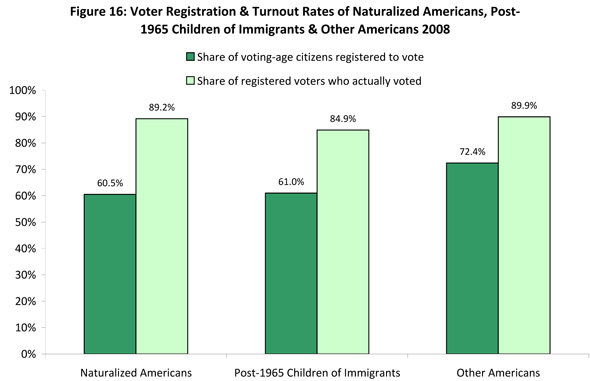
The same is true for Latino and Asian voters, whose registration numbers were significantly lower than white and black voters in 2004. However, registered Asians and Latinos did turn out to vote at the same rate as other groups (see Figure 17). Turnout by Latino voters jumped from 4.9 million in 1996 to 9.7 million in 2008, while turnout by Asian voters increased from 1.7 million to 3.5 million during this period.
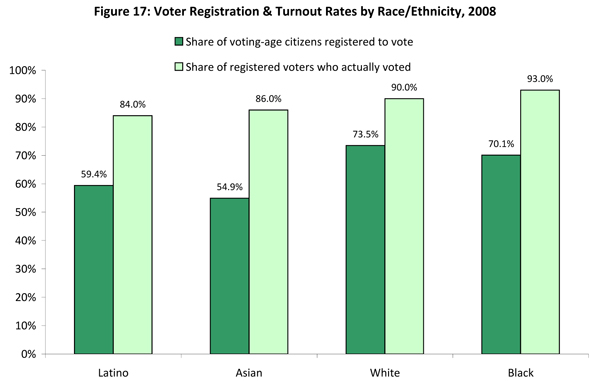
The number of New Americans eligible to vote has grown significantly since the 1996 Presidential election as record numbers of legal immigrants have applied for naturalization. According to data from the Office of Immigration Statistics [3], 9.8 million immigrants became naturalized citizens from Fiscal Year (FY) 1996 through FY 2009.
There are other indications that the potential electoral power of New Americans, Latinos, and Asians will continue to grow. The U.S. Census Bureau [4] has predicted that the Latino share of the U.S. population will double from 15 percent as of 2008 to 30 percent by 2050. The Asian share of the population is expected to rise from 5.1 percent to 9.2 percent during this time.
Conclusion
Registered voters who are New Americans (Naturalized Americans and the Post-1965 Children of Immigrants), or who belong to the Latino or Asian communities, are a significant portion of the American electorate. These groups are growing rapidly not only in states that have traditionally received immigrants, but also in states that have only recently begun to have more diverse populations. As a result, registered voters who are immigrants themselves or otherwise connected personally to the immigrant experience have significant electoral power at federal, state, and local levels. New Americans, Latinos, and Asians are casting ballots in record numbers. These voters will remember what candidates have said—or not said—about the value of immigrants and immigration.
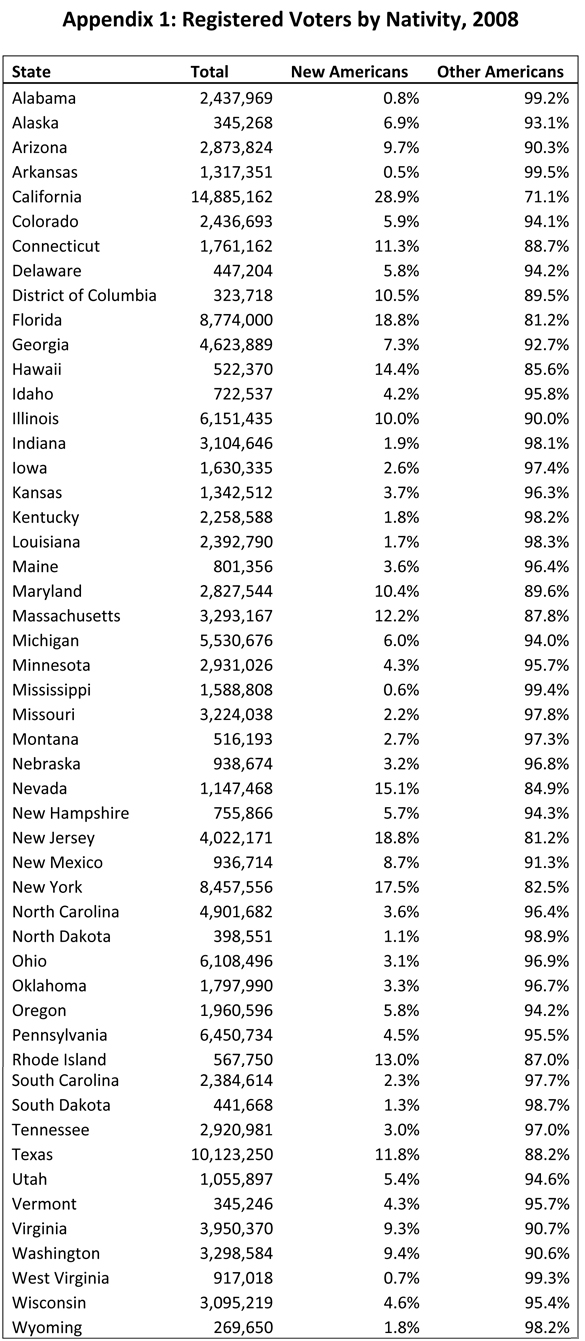
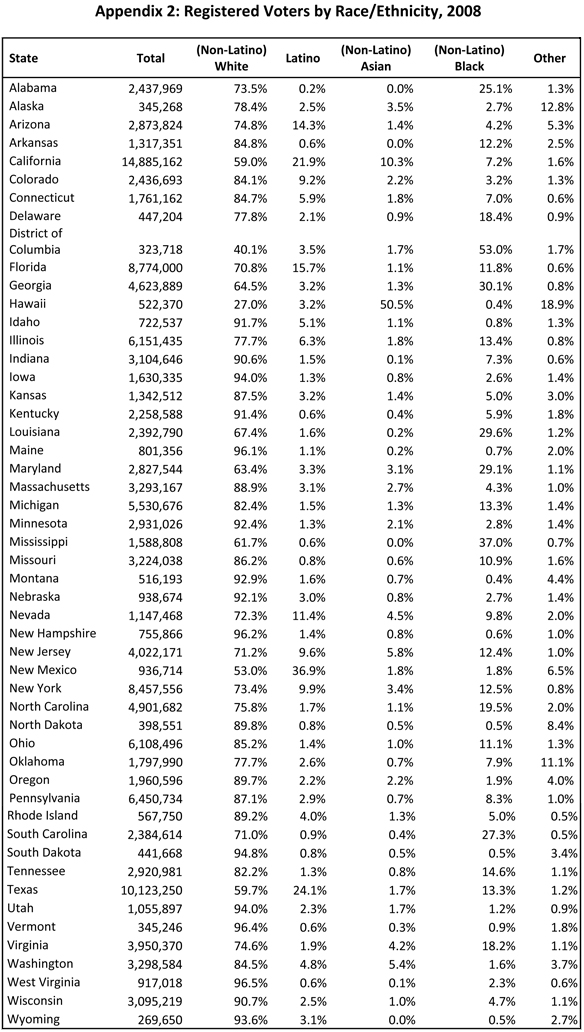
Published On: Thu, Oct 14, 2010 | Download File [2]